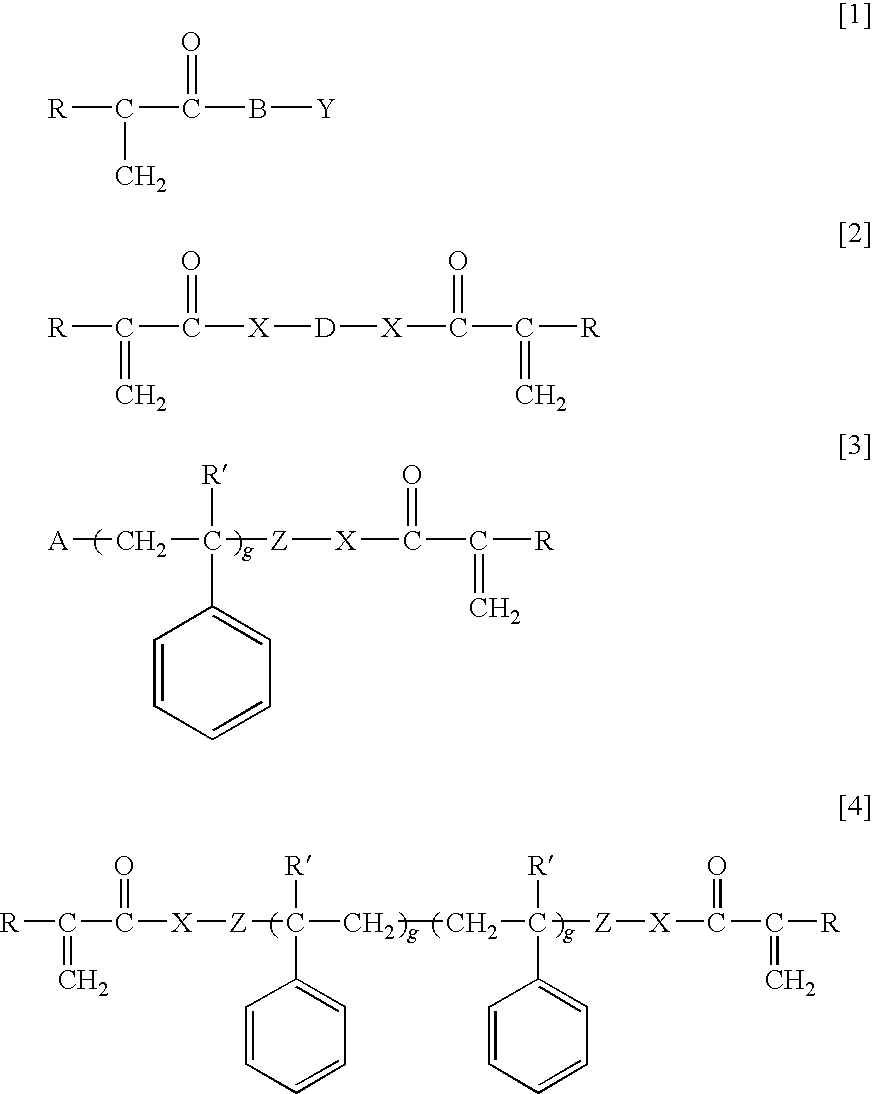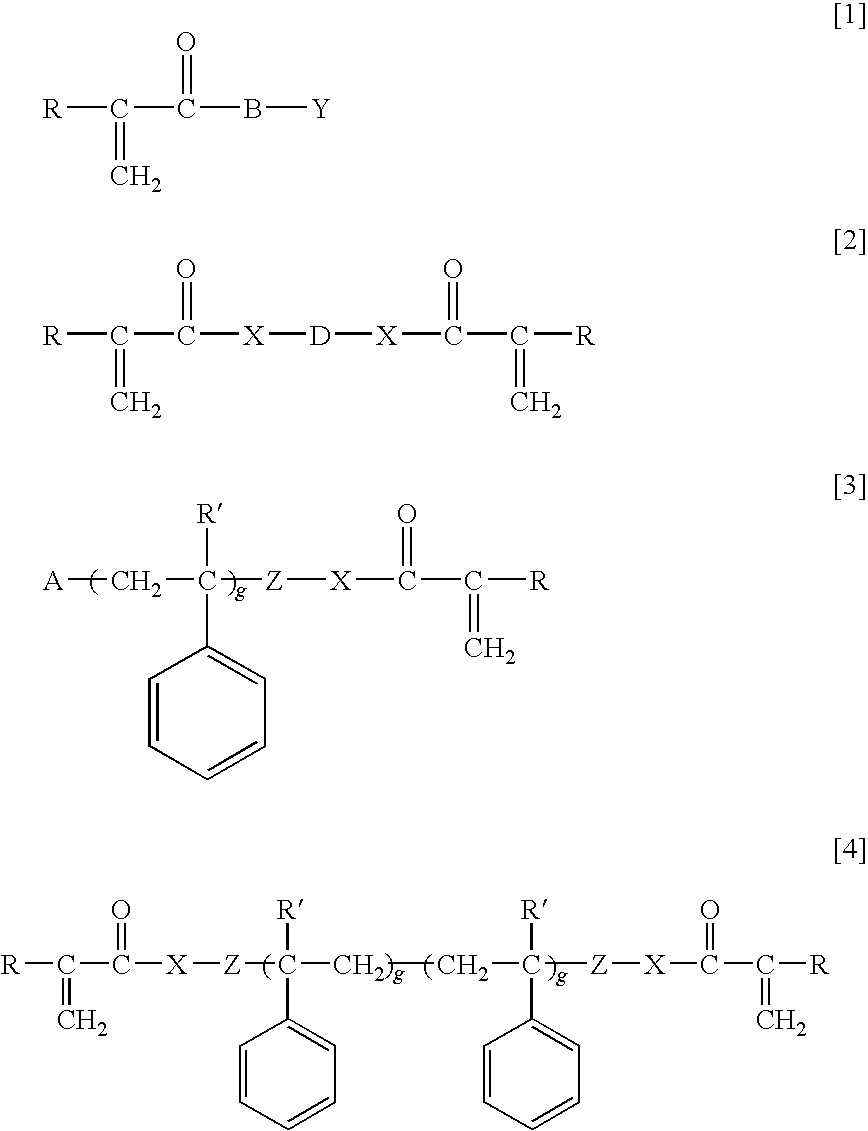Ophthalmic and otorhinolaryngological device materials
a technology of ophthalmology and otorhinolaryngology, which is applied in the field of improved ophthalmology and otorhinolaryngological device materials, can solve the problems of less desirable than other materials, explosive unfolding, and relatively low refractive index of hydrogel materials, so as to influence the surface properties of polymeric materials and improve the strength
- Summary
- Abstract
- Description
- Claims
- Application Information
AI Technical Summary
Benefits of technology
Problems solved by technology
Method used
Image
Examples
example 1
Thermally Initiated Copolymerization of Methacrylate Terminated poly(styrene) with 2-phenylethyl Acrylate and 1,4-butanediol Diacrylate
[0051]A 20-mL scintillation vial was charged with 1.3999 g of methacrylate terminated poly(styrene), 5.6535 g of 2-phenylethyl acrylate (PEA), and 0.0347 g of 1,4-butanediol diacrylate (BDDA). The vial was closed and agitated for about 1 hr to allow the polystyrene component to dissolve. The monomer mixture was filtered through a 1.0-micron glass fiber membrane, then through a 0.45-micron PTFE filter. The formulation was de-gassed by bubbling N2 through the monomer mixture. t-Butyl peroxy-2-ethylhexanoate (t-BPO) was added (0.0601 g) and the solution was mixed thoroughly. The monomer mixture was dispensed into vacuum de-gassed polypropylene molds under a N2 atmosphere. The filled molds were then placed in a mechanical convection oven and cured at 70° C. for 1 hr, then post-cured for 2 hrs at 110° C. The product was removed from the polypropylene mold...
example 2
Thermally Initiated Copolymerization of Styrene with 2-phenylethyl Acrylate and 1,4-butanediol Diacrylate
[0052]A 20-mL scintillation vial was charged with 2.0096 g of styrene, 7.9588 g of 2-phenylethyl acrylate (PEA), and 0.0565 g of 1,4-butanediol diacrylate (BDDA). The monomer mixture was mixed then filtered through a 0.45-micron PTFE filter. The formulation was de-gassed by bubbling N2 through the monomer mixture. t-Butyl peroxy-2-ethylhexanoate (t-BPO) was added (0.1050 g) and the solution was mixed thoroughly. The monomer mixture was dispensed into vacuum de-gassed polypropylene molds. The filled molds were then placed in a mechanical convection oven and cured at 70° C. for 1 hr, then post-cured for 2 hrs at 110° C. The product was removed from the polypropylene molds and the residual monomer was removed by acetone extraction at room temperature as indicated in Ex. 1. Representative properties are listed in Table 1.
TABLE 1Comparison of methacrylate terminated poly(styrene)graft...
example 3
UV Initiated Copolymerization of Methacrylate Terminated poly(styrene) (Mn 13,000) with 2-phenylethyl Acrylate and 1,4-butanediol Diacrylate
[0053]A 20-mL scintillation vial was charged with 2.0045 g of methacrylate-terminated polystyrene (Mn 13,000), 7.9528 g of 2-phenylethyl acrylate (PEA), and 0.0519 g of 1,4-butanediol diacrylate (BDDA). The vial was closed and the mixture was agitated for about 1 hr to allow the polystyrene component to dissolve. 2-Hydroxy-2-methyl-1-phenyl-propane-1-one (Darocur® 1173) was added (0.1050 g) and the solution was mixed thoroughly. The monomer mixture was filtered through a 1.0-micron glass fiber membrane, then a 0.45-micron PTFE membrane filter. The formulation was de-gassed by N2 bubbling then dispensed into vacuum de-gassed polypropylene molds under a N2 atmosphere. The filled molds were exposed to UV light for 20 min. The product was removed from the polypropylene molds and the residual monomer was removed by acetone extraction at room temperat...
PUM
| Property | Measurement | Unit |
|---|---|---|
| refractive index | aaaaa | aaaaa |
| glass transition temperature | aaaaa | aaaaa |
| Young's modulus | aaaaa | aaaaa |
Abstract
Description
Claims
Application Information
 Login to View More
Login to View More - R&D
- Intellectual Property
- Life Sciences
- Materials
- Tech Scout
- Unparalleled Data Quality
- Higher Quality Content
- 60% Fewer Hallucinations
Browse by: Latest US Patents, China's latest patents, Technical Efficacy Thesaurus, Application Domain, Technology Topic, Popular Technical Reports.
© 2025 PatSnap. All rights reserved.Legal|Privacy policy|Modern Slavery Act Transparency Statement|Sitemap|About US| Contact US: help@patsnap.com



